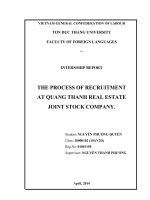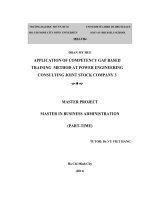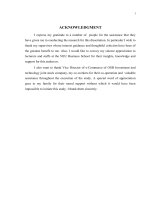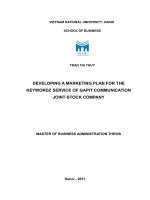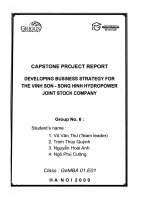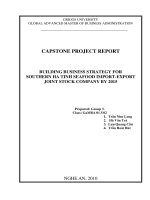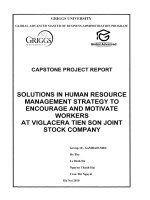33 COMPLETING LOGISTICS PROCESS FOR IMPORTING FCL AT VNLOGS IMPORT EXPORT JOINT STOCK COMPANY
Bạn đang xem bản rút gọn của tài liệu. Xem và tải ngay bản đầy đủ của tài liệu tại đây (528.11 KB, 91 trang )
MINSTRY OF FINANCE
ACDEMY OF FINANCE
BUI THI KIEU TRINH
Class: CQ53/05.02
GRADUATION THESIS
TOPIC:
COMPLETING LOGISTICS PROCESS FOR IMPORTING FCL AT
VNLOGS IMPORT EXPORT JOINT STOCK COMPANY
Major
: Customs and Foreign Trade
Code
: 05
Instructor
: DR. Vu Duy Nguyen
Ha Noi– 2019
DECLARATION
Bui Thi Kieu Trinh
CQ53/05.02
I hereby declare that this thesis is my own work and effort. It has
not been submitted anywhere for an award. Whatever information
sources have been used, they have been acknowledged.
Signature
Bui Thi Kieu Trinh
ABSTRACTS
2
Bui Thi Kieu Trinh
CQ53/05.02
This study investigated the reality of FCL import logistics process at
VNLOGS Import-Export Joint Stock Company from the view point of a
fourth year student of the faculty customs and trade foreign, the Academy
of Finance. The paper aims at finding out the drawbacks in the company’s
FCL import logistics process and the reasons, and more importantly
suggesting the main methods to improve FCL import and export logistics
processes in company. In achieving these aims, the graduation paper
surveys the current situation of the FCL import logistics process and
assesses whether it is effective or not. From received results, the study
argues the most practical implications at VNLOGS Import-Export Joint
Stock Company to complete steps in the company's FCL import logistics
process next year.
3
Bui Thi Kieu Trinh
CQ53/05.02
ACKNOWLEDGEMENT
I would like to express my deep gratituation to all those who have
given me the possibility to complete this graduation thesis. In preparing
this graduation thesis, I have had generous help and invaluable advices
from my teachers, my colleagues, my family and my friends. I would like
to express my great thanks to all of them.
First of all, I would like to express my deepest gratituation to my
supervisor, Vu Duy Nguyen, lecturer of Academy of Finance, who has
given immeasurable help, constant guidance with many careful
instructions, comments and valuable advices to me whenever I need.
Without her support, I am not able to have a complete thesis. And I really
appreciate her patience in reading and correcting my thesis.
Secondly, I wish to show my sincerely thanks to all of my teachers
at Academy of
Finance, who have provide me with worthy lessons
throughout 4 years of studying.
Moreover, I have to thank the staffs of VNLOGS import export joint
stock company for their valuable supports during my internship period.
Without their helps, it would be impossible for me to finish this work.
Last but not least, I would like to send my loving thanks to my
family whose great love and care in both spirit and health encourage me
to complete the thesis.
4
Bui Thi Kieu Trinh
CQ53/05.02
TABLE OF CONTENTS
5
Bui Thi Kieu Trinh
CQ53/05.02
LIST OF ABBREVIATIONS
A/N
Arrival notice
B/L
Bill of lading
CIF
Cost, Insurance and Freight
CFR
Cost and Freight
CY
Container yard
DC
Dry container
D/O
Delivery order
FCL
Full container load
FOB
Free On Board
FR
Flat Rack
FWD
HC
Forwarder
High cube
HS CODE
L/C
Harmonized Commodity
Descriptions and Coding Systerm
Letter of credit
OT
Open Top
6
Bui Thi Kieu Trinh
CQ53/05.02
LIST OF TABLES
7
Bui Thi Kieu Trinh
CQ53/05.02
LIST OF CHART
8
Bui Thi Kieu Trinh
CQ53/05.02
INTRODUCTION
1
Necessity of the study
Any country that wants to survive and grow, its business plays an
important role. In particular, in the era of economy following the trend of
globalization as today, accessing to the world market is an essential thing.
Foreign trade is a bridge to help exchange goods between domestic
enterprises and foreign businesses through trading. Import and export
activities are among the important activities that have a profound effect on the
whole economy and bring significant benefits to each country, especially
developing countries like Vietnam. In order for export and import activities to
take place smoothly and effectively, the import-export process must be carried
out logically, scientifically and professionally.
Along with the continuous development of the economy with the
development of technology learning, the process of import and export of
goods has been simplified and much easier to implement. However, there are
still many limitations and barriers in the import and export process. In
addition, the number of goods is increasing, especially the type of full
container loads (FCL), it is necessary to have solutions to improve the import
process at logistics companies. For the above reasons, I decided to choose the
topic: “COMPLETING LOGISTICS PROCESS FOR IMPORTING FCL AT
VNLOGS IMPORT EXPORT JOINT STOCK COMPANY”
2
Aims of the study and scope of the study
2.1
General objectives
Finding out the process for importing logistics FCL at VNLOGS
import export joint stock company
2.2
Specific objectives
9
Bui Thi Kieu Trinh
CQ53/05.02
Firstly, to systematize the basic arguments about sea logistics import
process in VNLOGS. Based on that to evaluate the status of the company.
Secondly, proposing some solutions to improve the financial situation and
improve the financial capacity of the company
2.3
The scope of the study
-
Scope of time: Analyzing data collected about the process for importing
logistics FCL at VNLOGS in 3 years from 2016 to 2018.
-
Scope of study: Researching topic at VNLOGS import-export joint stock
company
3
Methods of study
Based on knowledge at university, books and self-accumulation and
to achieve these above objectives, several methods of studying the thesis
are used as follow:
Figure collection:
Based on the data collected during the observational internship,
learn at the departments to make a preliminary assessment of the
company's import and export activities. Along with the internal data of
the company through the financial reports, Income statement, data from
departments of VnLogs Import-Export Joint Stock Company in the period
2016- 2018.
Descriptive statistics method:
As a method of collecting information and data for the purpose of
general preliminary assessment of the situation of the company, it helps
to make preliminary conclusions for the research topic: assessing the
current situation of joint stock companies import and export VNLOGS
implements FCL import logistics process through data collected from
internal documents in the period 2016-2018
Analysis method:
10
Bui Thi Kieu Trinh
CQ53/05.02
The analytical method is the way to use the logical thinking process
to study and compare the statistical data from the internal documents of
the Company's performance along with the assessments that we identify.
Previously, to assess the current situation of FCL import logistics process
at Vnlogs Import-Export Joint Stock Company, assess the reasonableness
or unreasonableness of these data to see if it is wrong.
Summarizing:
Summarizing the analyzes and comparisons to make comments and
assess the status of FCL import logistics process at Vnlogs Import-Export
Joint Stock Company, thereby making suggestions and measures to
complete improve FCL import logistics process at VNLOGS Import and
4
Export Joint Stock Company.
Expected results
During the internship at the company, I found that logistics activities
for importation of FCL still had some difficulties. Therefore, the urgent
issue for VNLOGS Import-Export Joint Stock Company to do in order to
gradually improve the process of implementing import contracts, thereby
improving the efficiency of international business, bringing the
foundation, economic development of the country
11
Bui Thi Kieu Trinh
5
CQ53/05.02
Organization of the study
Besides the Contents, Introduction, Conclusion and References, the
thesis consists of 3 chapters:
Chapter 1: THEORETICAL BACKGROUND OF LOGISTICS PROCESS
TO IMPORT FCL AT VNLOGS IMPORT EXPORT JOINT STOCK
COMPANY.
Chapter 2: CURRENT SITUATION OF LOGISTICS PROCESS
FOR IMPORT FCL AT VNLOGS IMPORT EXPORT JOINT STOCK
COMPANY
Chapter
3:
DEVELOPMENT
ORIENTATIONS
AND
SOME
SOLUTIONS TO IMPROVE EFFICIENCY OF LOGISTICS PROCESS TO
IMPORT FCL AT VNLOGS IMPORT EXPORT JOINT STOCK COMPANY .
12
Bui Thi Kieu Trinh
CQ53/05.02
CHAPTER 1:THEORETICAL BACKGROUND OF LOGISTICS PROCESS TO
IMPORT FCL AT VNLOGS IMPORT EXPORT JOINT STOCK COMPANY .
1.1
1.1.1
OVERVIEW OF FCL
Definition of FCL
In the past, after the Second World War, to buy and sell goods trucks,
people had to pick up the craft between the means of transport and it was
necessary to have the warehouse to gather goods while waiting for
people to load and discharge from the means of transport.
However, after the World War II, increasing free trade between
countries results in long-distance transportation needs, despite the
change in many types of transport: train, truck, ship, .... Since then, a lot of
loading and discharging blocks replaced vehicles; depending on the
sunny and rainy weather, they must have warehouses to gather goods
between many points which led to increased costs; The appearance of
container compensated for these things. So, the model of transportation
by containers to pack the FCL goods has been used up to now.
In one side, FCL means "Full Container Load", which is used in the
international shipping industry for the export and import of sea freight.
This term is often used to describe an international sea service
designed for ocean freight shipments of goods that an export or import
country has an exclusive use of a specialized sea shipping container
(usually a 20ft or 40ft container). Sea shipping containers are usually
loaded and sealed at the origin and then transported by a combination of
sea, rail and/or road to the end point.
In other side, the shipping lines define the term FCL as follows:
FCL is full container load, The Shipper and The Consignee are
responsible for packing and unloading the container. When the shipper
13
Bui Thi Kieu Trinh
CQ53/05.02
has a homogeneous cargo volume sufficient to fill a container or multiple
containers, one or more containers are rented.
1.1.2
Characteristics of FCL
Transporting import and export goods by containers is becoming
popular in international transport. The technical process of container
shipping requires strict requirements from loading, sending to
discharging shipment and delivering to the consignee.
These following features:
FCL is a commodity for volume large or size large that fit in 1 or
more containers. Therefore, the fee will be charged by container, for
example: FOB Qingdao - Hai Phong: 350/480 USD (350 USD / Cont 20”,
480 USD / Cont40’). But not all container charges have the same price.
Each container has different characteristics, the price will be different:
Cont DC, HC, OT, FR, FV ...
The attention to the situation of foreign trade activities in the world
is very important. Due to the price fluctuation, the peak season of import
and export goods has made a sudden increase, or when the fuel fee is
increased, the price of ships also increases.
1.1.2.1. Technical FCL packaging
According to international custom, when shipping goods by
container, the shipper is responsible for closing FCL goods with the
sealing, leading of container and they must bear all related costs except
for the case when the consignment goods are not fully packed with
containers, they are sent by LCL. Therefore, when receiving the container
from the consigner, the carrier cannot understand specifically the FCL
stacking goods situation, they can only base on the declaration of the
consigner. Accordingly, they will not be responsible for the consequences
14
Bui Thi Kieu Trinh
CQ53/05.02
of unreasonable, untechnical handling of goods, leading to the loss of
goods and transport tools.
a.
Characteristics of freight
Not all goods are suitable for container shipping, so determining the
source of goods suitable for shipping by container is important in
business.
From the perspective of container transportation, freight is divided
into 4 groups:
Group 1: The goods are completely suitable for transport by
container: Including: general goods, canned food, medical materials,
plastic or rubber, household tools, yarns, fabrics, metal products, toys,
furniture ... The goods are transported by general containers or insulated
containers .... depending on the specific requirements of the cargo
characteristics.
Group 2: Types of goods suitable for container transport
conditions
Including: Coal, ore, kaolin ... which are low value products and large
quantities of trade. These items in terms of natural as well as technical
properties are completely suitable for container transportation but in
terms of economic efficiency is not appropriate (the ratio between freight
and value of goods.)
Group 3: These goods have special physical and chemical
properties
Including: perishable goods, frozen goods, live animals, super heavy
goods, dangerous goods .... These goods must be paid with dedicated
containers such as insulation containers, ventilated containers, flat
containers, animal containers ...
15
Bui Thi Kieu Trinh
CQ53/05.02
Group 4: Types of goods suitable for transporting by containers
Including: waste, super-length and super-weighted goods, heavyduty trucks, radioactive substances ...
b.
Determining and checking container types when using.
When detecting that a container does not meet the technical
standards, it is required to immediately notify the carrier, absolutely do
not accept, or request to complete or change another container. If the
inspection is not attentive, receiving containers that do not meet the
technical requirements, during the transport process, there are losses
caused by the defects of the container, the shipper must bear all the
consequences.
Including:
Firstly, check the outside of the container:
Observe and detect
scratches, damage, cracks, holes, deformed distortions due to impact ....
Check the assembly of the containers because this is often overlooked but
it is critical structure of containers related to transport safety.
Secondly, check the inside of the container: Check the tightness by
closing the door from the inside to observe the light rays passing through
to detect holes or cracks. Check if the screws are damaged or raised.
Check cover sheets or other equipment such as ventilation holes, cold air
pipes ....
Thirdly, check the container’s door: The situation works when
opening and closing door and door locks ... ensuring that the door is
opened and closed securely, sealed to prevent water from entering.
Finally, check the status of container hygiene: Containers must be
cleaned well, dry, odorless or dirty; Packing FCL that does not meet
hygiene standards will result in loss of goods and will be easily rejected
when the health authorities of the country of shipment check it.
16
Bui Thi Kieu Trinh
c.
-
a.
CQ53/05.02
Technical loading, inserting FCL
When conducting loading and discharging FCL goods, it is necessary
to note the following technical requirements:
Allocating goods on container floor.
Inserting and padding FCL goods.
Limiting and reducing pressure or vibration.
Against the phenomenon of hot and steamed goods.
1.1.2.2. FCL Shipping Method
According to the FCL method, the responsibility for delivery,
handling and other costs is divided as follows:
The responsibility of the shipper:
The shipper has the following responsibilities:
Renting and transporting empty containers to your warehouse or
storing for packing. The second responsibility is packing FCL including
stowage, dunnage FCL. Next, marking the goods symbol and transport
symbol. Moreover, doing customs procedures and lead sealing according
to export regulations ; Transporting and delivering containers to carriers
at CY, and receiving bills of lading issued by carriers. Also, they have to
bear the costs associated with the above operations.
In some situations, the goods package can also be proceeded in
packing station or the carrier's container yard. Shippers must transport
their goods to container yard and ship goods.
b.
Responsibilities of the carrier:
The carrier has the following responsibilities:
They have to release bills of lading for shippers and manage, care,
send and load goods from receiving containers at container yard
(container yard) at sending port to the delivery to the consigner at the
destination port’s container yard; Furthermore, unloading containers
from sending port to ship to transport, including stowing containers onto
ships and unloading the container from the ship to the destination port’s
17
Bui Thi Kieu Trinh
CQ53/05.02
container yard . They also take responsibility for delivering the container
to the consigner with a valid bill of lading at the container yard and
c.
bearing the costs associated with the above operations.
Responsibilities of the consignee:
The consignee has the following responsibilities:
Firstly, arranging document and import customs procedures for
shipments and exporting a valid bill of lading with the carrier to receive
the goods at the container yard. Secondly, transporting containers to their
warehouses, quickly withdrawing and returning empty containers to
carriers (or container leasing companies). Thirdly, bearing all costs
related to the above operation, (including the cost of transporting
containers to the container yard).
1.1.2.3 Documents of container transportation
a.
Bill of lading by way of sending FCL / FCL
Documents of container shipping of goods called Container Bill of
Lading, signed by the carrier or their representative to the shipper after
receiving the lead-sealed container for transport.
Normally, the bill of lading is signed before the container is loaded
onto the ship, because it is Received for Bill of Lading. In general, for this
type of bill of lading (if payment by voucher credit - L / C), the bank
usually does not accept payment unless in the letter of credit it mentions
"Received for Bill Lading Acceptable".
Therefore, when the container has been loaded onto the ship, the
shipper should ask the carrier for additional notes on the bill of lading: "
Shipped on board, on ... and signed confirmation. At this time, the bill of
lading becomes "Shipped on board Bill of Lading" and is accepted by the
bank as a payment document.
b. Cargo manifest
is a summary list of goods to be transported.
18
Bui Thi Kieu Trinh
CQ53/05.02
It is used to make a notice to the consignee about the goods loaded
onto the ship or make vouchers for customs declaration ; Moreover, cargo
manifest can be used as a basis for payment of costs related to goods or
c.
for comparing with B / L about goods details.
Delivery order (D/O)
Delivery order is a document issued by the carrier or shipping agent
d.
to the consignee to request the port of delivery to the consigner.
Arrival notice:
Arrival notice has the effect of informing to the goods owners that
their goods have arrived and requested them to promptly carry out the
procedures and documents to the order delivery agent.
1.1.2.4. Limitation of liability for compensation.
The maximum compensation limit of the carrier prescribed in the
conventions are different:
-
Hague Rules – 1924: ( following article 4)
Goods having declared value on bill of lading, compensated according to
-
declared value
For non-declared goods, the compensation is no more than 100 pounds
-
-
for a unit of goods or a package.
Goods transported by containers are not mentioned.
Visby Rules – 1968: ( following article 4)
Goods declared with compensation value according to declared value.
Goods are not declared value, compensation level is:
+ 10,000 francs per unit of goods or a package
+ 30 francs for a kilo of goods including packing.
Goods transported by container:
+ Packages of FCL or pallets ... declared on the bill of lading will be
considered as a unit of goods claiming compensation.
+ Without declaring on the bill of lading, a container is considered a
-
unit of goods claiming compensation.
SDR protocol – 1979: ( following article 2)
Goods with declared value of compensation according to the declared
value.
19
Bui Thi Kieu Trinh
-
-
-
-
CQ53/05.02
Aviation declared value, the compensation level is:
+ 666.67 SDR for a unit of goods or a package
+ 2 SDR for 1kg of goods including packaging
Hambuge Rulls 1978: ( following article 6)
Goods with value declaration and compensation according to the
declared value.
Aviation declared value, the level of compensation is:
+ 835 SDR for a unit of goods or a package
+ 2,5 SDR for 1kg of goods including packaging.
The liability of the carrier for delay in delivery compensates an amount
which is equivalent to two and a half times of the freight payable for the
goods delayed, but not exceeding the total freight payable under the
-
contract of carriage of goods by sea.
Goods transported by container:
+ Packages of FCL or pallets ... declared on the bill of lading will be
considered as a unit of goods claiming compensation.
+ Without declaring on the bill of lading, a container is considered as
-
a unit of goods claiming compensation.
VietNam martime code -1990:
Limit the specified compensation like Visby Rules.
Goods transported by containers are not mentioned.
1.1.2.5 Charges in the transport of goods by container.
In shipping goods by containers, container freight charges are set
into the tariffs of shipping lines. Container shipping charges usually
include: domestic transport costs; costs of transporting containers at the
main road and expenses for berths as well as container yards at loading
and discharging ports and other costs...
Container fee rates depend on the following factors:
The type and the size of container (large or small, dedicated or not
specialized) as well as type of FCL, which is based on the class of goods ;
it is also depended on level used of container tonnage, length and
characteristics of transport routes.
20
Bui Thi Kieu Trinh
CQ53/05.02
From the conditions of delivery, loading and unloading equipment, to
modes of transportation are changed… To keep with this advanced
shipping method, container shipping companies have launched their
tariffs to serve customers, container charges including 2 types:
Type 1: Freight for container transportation calculated by goods
This is the gross amount of freight for transporting a container
containing a separate item. The carrier relies on the average usability of
the container to calculate the rate (example: 14 tons of 20-foot
container). With this calculation, if the shipper adds more goods, it will be
beneficial. Regularly large shippers like this type of charge and small
shippers don't like it. For the carrier, the simple way to charge a round
container is to reduce administrative costs.
Type 2: Container charges are calculated for all types of goods
According to this calculation, all items must be paid at the same
freight for the same container without taking into account the value of
FCL. The carrier is basically based on the estimated total cost of the trip
divided by the number of containers expected to ship. With CBR rates,
FAK rates are more reasonable because the loading, unloading and
occupancy units are containers. For the carrier to apply, this fee will
reduce the calculation. But this kind of freight also has shortcomings that
shippers have higher value goods will be more beneficial, while low-value
shippers is in a disadvantage.
In short, transporting goods by containers holds an important
position in the transport system serving the national economy. This is an
advanced transport method that has brought high efficiency in special
transportation by sea transport. Therefore, when being compared to the
development history of sea transport, container shipping has just been
21
Bui Thi Kieu Trinh
CQ53/05.02
born, but the growth rate is quite fast. To create the ability to apply this
modern transport method, many countries around the world have built a
specialized fleet of large tonnage vessels to transport containers. To build
container ports with modern and automated loading and unloading
equipment with fully equipped warehouses and yards to fully exploit the
advantages of FCL cargo transported by sea.
22
Bui Thi Kieu Trinh
CQ53/05.02
1.2 Logistics process to import FCL
Diagram 2.1: Logistics process to import FCL
Receive requests from public
customers
refuse
Agree
contract signing
Organization receiving import goods
Liquidation of contracts
Resolve complaints
Source: (export-import dept’s 2019)
Content:
(1). Receiving requests from public customers
- If it is unable to meet customer requirements, decline.
- If you agree, proceed to sign the Contract.
After signing the Contract, go to step 2
(2). Organization receiving import
Whether the customer is a domestic importer or an international
forwarding company, the forwarder still has to do one of the following:
The first step is asking price: After the two parties agree, FWD will
report the number of containers, goods name, weight, expected date of
shipment, delivery conditions, port of Loading, destination port,
23
Bui Thi Kieu Trinh
CQ53/05.02
warehouse and the name of the trader in foreign countries , number
phone , email ...
Next, getting your booking, confirm the bill: After having a booking,
FWD reports the train schedule and sends draft bill to check. Then, check
the accuracy of information on the bill and confirm the bill correctly:
Check sender and consignee; Name of goods, quantity, number of invoice,
number of packages, weight; port of Loading and port of Discharge; name
of means of transport, container number, seal number and specific
schedule are provided and inspected by FWD. After the goods arrive,
FWD will send the Arrival Notice (Arrival Notice), the information on A /
N will usually be: Name of the exporter and importer; Date of shipment,
name of means of transport, details of goods; Information of the
destination of the tax security destination , place of receipt; Detail the
local charges at the port.
Then, preparing Import Document: Records include: Commercial
Invoice ( copy ); packing details (copy); Account information Vinacss,
digital signature (online declaration); Notice of arrival (name of ship,
destination of tax guarantee, port of discharge, ...) (copy); delivery order
(orignal) ; Vietnamese goods name, HS code to calculate import tax, VAT
and other taxes if any.
After that, implementing import customs procedures: Transmitting
online declarations and viewing the results of customs flow distribution
(green channel: submitting to HS code and customs clearance; yellow
channel: checking HS code; red flow checking HS code and checking
actual goods according to declaration)
Also, importing tax payment: The customs check the tax calculated
in the customs declaration form in accordance with the actual amount
that the enterprise must pay. If the business has to pay tax immediately,
24
Bui Thi Kieu Trinh
CQ53/05.02
the forwarder pays tax and the copy of the receipt pays money into the
State budget.
Next, dragging the item to the warehouse: After checking valid
documents, send the customs clearance form and D/O (original) to the
fleet and arrange to return the container to the warehouse.
Finally, saving import records: Keep 1 copy of the documents for the
company, and send the original documents to the importing enterprise
(3). Liquidation of contracts
Payment of delivery related expenses such as storage, storage,
loading and unloading costs ... , and pay commissions, unfinished fines if
any . When the goods are available to the staff to track the receipt results,
settle complaints about goods if any
(4). Resolve complaints about loss of goods
In one side, prepare the original legal documents to protect the
rights of goods owners such as the internal inspection report, the
certificate of receipt of surplus goods compared to the declaration.
In other side, invite reputable inspection organizations, conduct the
determination of the whole lot of goods, the purpose of determining
clearly the number of goods subjected to specific loss of the whole lot as a
basis to claim compensation. The content must be accurate and it must
state the status and extent of the loss. This document will be issued by the
inspection agency immediately after the assessment is completed within
no more than 30 days from the date of request for assessment.
The responsibilities of the FCL shipper:
Book container and get to the port to pick up the container, transport
it to the warehouse for packing and provide detailed information for the
carrier to the bill of lading , pack FCL and make a fixed order to ensure
25
